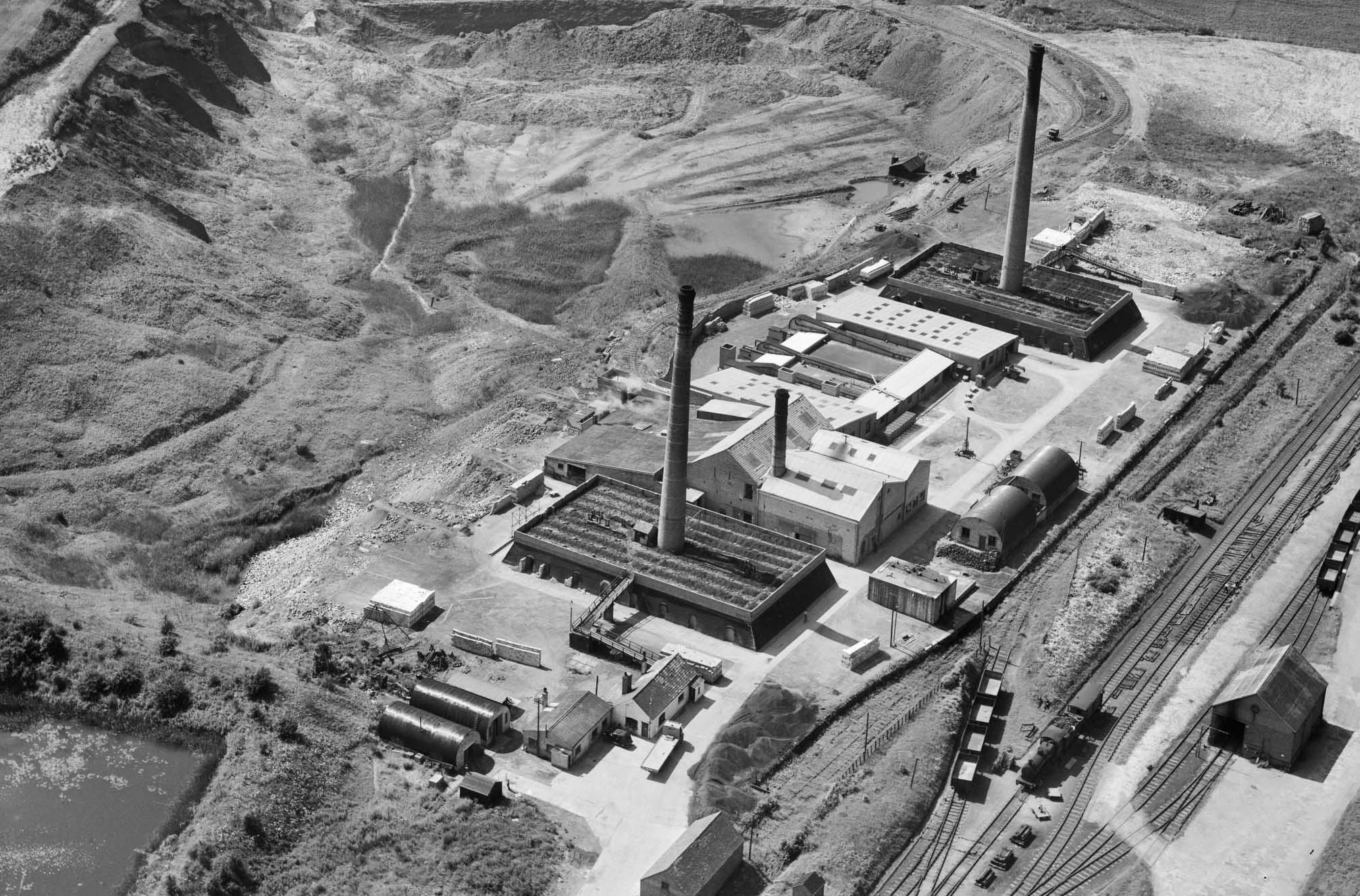 A view over Warboys brickworks looking west in June 1953. The two rectangular structures with tall chimneys are Hoffmann kilns. If the name sounds German, it is; the kiln was designed and patented by Friedrich Hoffmann in 1858. The Hoffmann kilns at Warboys were superseded by an oil-fired tunnel kiln in 1955 and the structures demolished in 1966. A number of Nissen huts can be seen. These originated during WWI but are more familiar from WWII aerodromes. It is quite possible that those seen here were purchased as military surplus after WWII. At bottom left part of the reservoir can be seen and dominating the scene above it is the enormous clay pit. The small building at the bottom of the pit was the powerhouse for a conveyor which took extracted clay to the upper level for loading into narrow gauge skip wagons. Around the perimeter of the pit and disappearing behind the building adjacent to the nearest kiln can be seen part of the narrow gauge system. To the right of the farthest chimney one of the Simplex diesel locomotives can just be seen. Also just discernable are a couple of London Brick Co lorries; one at bottom centre and another to the left of the farthest kiln. Warboys railway station is largely out of view at the bottom of the picture but the goods shed and part of the yard can be seen bottom right. Clearly visible is the siding serving the brickworks, with four wagons stabled on the connecting spur. It would appear that the loading dock was the area adjacent to the points, just below the two end-on Nissen huts. The siding divides into two at the bottom of the picture and appearances suggest loading was once undertaken along a rather longer length of the platform. The siding extends to buffers just off the picture at top right. If both sidings towards the bottom of the picture were used, one for holding loaded wagons, it would appear capacity was 14 or 15 wagons. In this view the siding appears disused although a 1961 photograph shows the connection, at least, to be apparently well used. Standing on the running line with a brake van is what appears to be a Class J17 0-6-0. To the left of the brake van are two men, probably the locomotive crew having a little break from the footplate before returning to Somersham.
A view over Warboys brickworks looking west in June 1953. The two rectangular structures with tall chimneys are Hoffmann kilns. If the name sounds German, it is; the kiln was designed and patented by Friedrich Hoffmann in 1858. The Hoffmann kilns at Warboys were superseded by an oil-fired tunnel kiln in 1955 and the structures demolished in 1966. A number of Nissen huts can be seen. These originated during WWI but are more familiar from WWII aerodromes. It is quite possible that those seen here were purchased as military surplus after WWII. At bottom left part of the reservoir can be seen and dominating the scene above it is the enormous clay pit. The small building at the bottom of the pit was the powerhouse for a conveyor which took extracted clay to the upper level for loading into narrow gauge skip wagons. Around the perimeter of the pit and disappearing behind the building adjacent to the nearest kiln can be seen part of the narrow gauge system. To the right of the farthest chimney one of the Simplex diesel locomotives can just be seen. Also just discernable are a couple of London Brick Co lorries; one at bottom centre and another to the left of the farthest kiln. Warboys railway station is largely out of view at the bottom of the picture but the goods shed and part of the yard can be seen bottom right. Clearly visible is the siding serving the brickworks, with four wagons stabled on the connecting spur. It would appear that the loading dock was the area adjacent to the points, just below the two end-on Nissen huts. The siding divides into two at the bottom of the picture and appearances suggest loading was once undertaken along a rather longer length of the platform. The siding extends to buffers just off the picture at top right. If both sidings towards the bottom of the picture were used, one for holding loaded wagons, it would appear capacity was 14 or 15 wagons. In this view the siding appears disused although a 1961 photograph shows the connection, at least, to be apparently well used. Standing on the running line with a brake van is what appears to be a Class J17 0-6-0. To the left of the brake van are two men, probably the locomotive crew having a little break from the footplate before returning to Somersham.
Reproduced with the kind permission of Simmons Aerofilms Ltd

